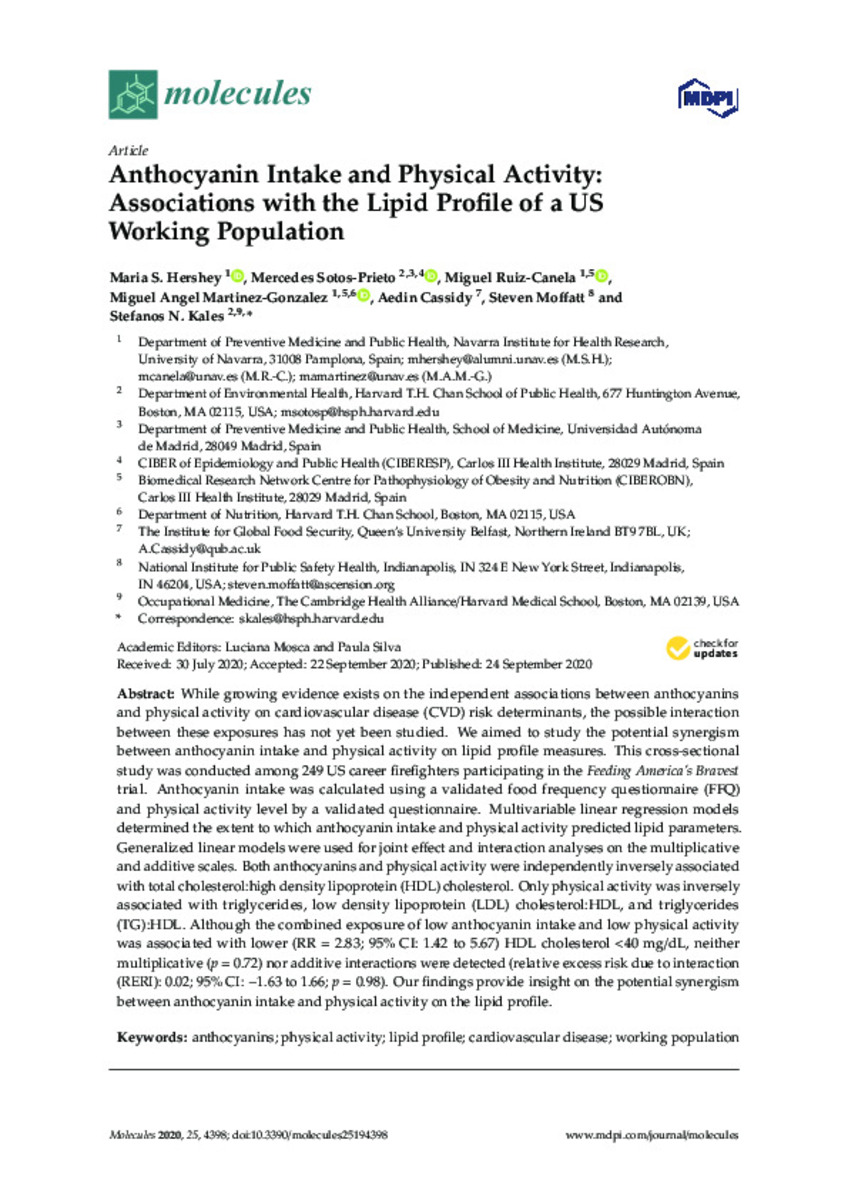Full metadata record
| DC Field | Value | Language |
|---|---|---|
| dc.creator | Hershey-de-la-Cruz, M.S. (María Soledad) | - |
| dc.creator | Sotos-Prieto, M. (Mercedes) | - |
| dc.creator | Ruiz-Canela, M. (Miguel) | - |
| dc.creator | Martinez-Gonzalez, M.A. (Miguel Ángel) | - |
| dc.creator | Cassidy, A. (A.) | - |
| dc.creator | Moffatt, S. (Steven) | - |
| dc.creator | Kales, S.N. (Stefanos N.) | - |
| dc.date.accessioned | 2023-02-06T10:00:29Z | - |
| dc.date.available | 2023-02-06T10:00:29Z | - |
| dc.date.issued | 2020 | - |
| dc.identifier.citation | Hershey-de-la-Cruz, M.S. (María Soledad); Sotos-Prieto, M. (Mercedes); Ruiz-Canela, M. (Miguel); et al. "Anthocyanin Intake and physical activity: associations with the lipid profile of a US working population". Molecules. 25 (19), 2020, 4398 | es_ES |
| dc.identifier.issn | 1420-3049 | - |
| dc.identifier.uri | https://hdl.handle.net/10171/65272 | - |
| dc.description.abstract | While growing evidence exists on the independent associations between anthocyanins and physical activity on cardiovascular disease (CVD) risk determinants, the possible interaction between these exposures has not yet been studied. We aimed to study the potential synergism between anthocyanin intake and physical activity on lipid profile measures. This cross-sectional study was conducted among 249 US career firefighters participating in the Feeding America's Bravest trial. Anthocyanin intake was calculated using a validated food frequency questionnaire (FFQ) and physical activity level by a validated questionnaire. Multivariable linear regression models determined the extent to which anthocyanin intake and physical activity predicted lipid parameters. Generalized linear models were used for joint effect and interaction analyses on the multiplicative and additive scales. Both anthocyanins and physical activity were independently inversely associated with total cholesterol:high density lipoprotein (HDL) cholesterol. Only physical activity was inversely associated with triglycerides, low density lipoprotein (LDL) cholesterol:HDL, and triglycerides (TG):HDL. Although the combined exposure of low anthocyanin intake and low physical activity was associated with lower (RR is 2.83; 95/100 CI: 1.42 to 5.67) HDL cholesterol 40 mg/dL, neither multiplicative (p is 0.72) nor additive interactions were detected (relative excess risk due to interaction (RERI): 0.02; 95/100 CI: -1.63 to 1.66; p is 0.98). Our findings provide insight on the potential synergism between anthocyanin intake and physical activity on the lipid profile. | es_ES |
| dc.description.sponsorship | This research was funded by the US Department of Homeland Security, grant number EMW-2014-FP-00612 | es_ES |
| dc.language.iso | spa | es_ES |
| dc.publisher | MDPI | es_ES |
| dc.rights | info:eu-repo/semantics/openAccess | es_ES |
| dc.subject | Anthocyanins | es_ES |
| dc.subject | Cardiovascular disease | es_ES |
| dc.subject | Lipid profile | es_ES |
| dc.subject | Physical activity | es_ES |
| dc.subject | Working population | es_ES |
| dc.title | Anthocyanin Intake and physical activity: associations with the lipid profile of a US working population | es_ES |
| dc.type | info:eu-repo/semantics/article | es_ES |
| dc.description.note | This article is an open access article distributed under the terms and conditions of the Creative Commons Attribution (CC BY) license | es_ES |
| dc.identifier.doi | 10.3390/molecules25194398 | - |
| dadun.citation.number | 19 | es_ES |
| dadun.citation.publicationName | Molecules | es_ES |
| dadun.citation.startingPage | 4398 | es_ES |
| dadun.citation.volume | 25 | es_ES |
| dc.identifier.pmid | 32987892 | - |
Files in This Item:
Statistics and impact
Items in Dadun are protected by copyright, with all rights reserved, unless otherwise indicated.






